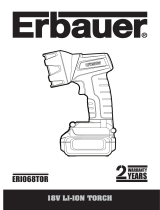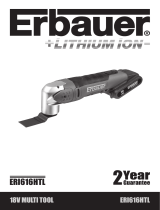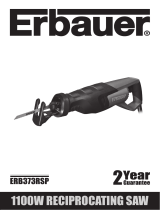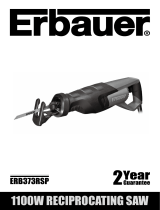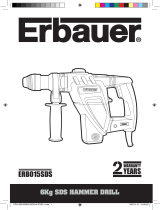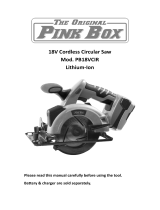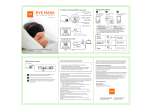
18V CORDLESS JIGSAW
ERI065JSW
WARRANTY
YEARS
M-CSJ18L.1-071008.indd 1 2007-10-8 16:19:49

M-CSJ18L.1-071008.indd 2 2007-10-8 16:19:49

18V CORDLESS JIGSAW
GUARANTEE
This
product carries a guarantee of 24 months. If your product develops a
fault within this period, you should in the first instance contact the retailer where the
item was purchased.
This guarantee specifically excludes losses caused due to:
- Fair wear and tear
- Misuse or abuse
- Lack of routine maintenance
- Failure of consumable items (such as batteries)
- Accidental damage
- Cosmetic damage
- Failure to follow manufacturer’s guidelines
- Loss of use of the goods
This guarantee does not affect your statutory rights. This guarantee is only valid in the UK.
For further technical advice, spare parts or repair service (outside of guarantee) please
contact the customer helpline number on 0845 607 6380
Congratulations on your purchase of a quality power tool from Erbauer (UK)
Ltd. This product should give you reliable service but for your peace of mind
this
power tool does carries a 24-month guarantee, the terms of
which are detailed below.
If this product develops a fault within the guarantee period contact your
retailer.
Please retain this handbook in case you need to refer to safety, care or guarantee
information in the future.
M-CSJ18L.1-071008.indd 3 2007-10-8 16:19:49

SAFETY INSTRUCTIONS
Warning! Read all safety warnings and all instructions. Failure to follow
the warnings and instructions may result in electric shock, fire and/or serious
injury.
Save all warnings and instructions for future reference.
The term “power tool” in the warnings refers to your mains-operated (corded) power
tool or battery-operated (cordless) power tool.
1. Work area safety
a. Keep work area clean and well lit. Cluttered or dark areas invite accidents.
b. Do not operate power tools in explosive atmospheres, such as in the
presence of flammable liquids, gases or dust. Power tools create sparks
which may ignite the dust or fumes.
c. Keep children and bystanders away while operating a power tool.
Distractions can cause you to lose control.
2. Electrical safety
a. Power tool plugs must match the outlet. Never modify the plug in any
way. Do not use any adapter plugs with earthed (grounded) power tools.
Unmodified plugs and matching outlets will reduce risk of electric shock.
b. Avoid body contact with earthed or grounded surfaces, such as pipes,
radiators, ranges and refrigerators. There is an increased risk of electric shock
if your body is earthed or grounded.
c. Do not expose power tools to rain or wet conditions. Water entering a
power tool will increase the risk of electric shock.
d. Do not abuse the cord. Never use the cord for carrying, pulling or
unplugging the power tool. Keep cord away from heat, oil, sharp edges or
moving parts. Damaged or entangled cords increase the risk of electric shock.
e. When operating a power tool outdoors, use an extension cord suitable
for outdoor use. Use of a cord suitable for outdoor use reduces the risk of electric
shock.
f. If operating a power tool in a damp location is unavoidable, use a
residual current device (RCD) protected supply. Use of an RCD reduces the
risk of electric shock.
3. Personal safety
a. Stay alert, watch what you are doing and use common sense when
operating a power tool. Do not use a power tool while you are tired or
under the influence of drugs, alcohol or medication. A moment of inattention
while operating power tools may result in serious personal injury.
b. Use personal protective equipment. Always wear eye protection.
Protective equipment such as dust mask, non-skid safety shoes, hard hat, or
hearing protection used for appropriate conditions will reduce personal injuries.
c. Prevent unintentional starting. Ensure the switch is in the off-position
before connecting to power source and/or battery pack, picking up
or carrying the tool. Carrying power tools with your finger on the switch or
energising power tools that have the switch on invites accidents.
M-CSJ18L.1-071008.indd 4 2007-10-8 16:19:50

18V CORDLESS JIGSAW
d. Remove any adjusting key or wrench before turning the power tool on.
A wrench or a key left attached to a rotating part of the power tool may result in
personal injury.
e. Do not overreach. Keep proper footing and balance at all times. This
enables better control of the power tool in unexpected situations.
f. Dress properly. Do not wear loose clothing or jewellery. Keep your hair,
clothing and gloves away from moving parts. Loose clothes, jewellery or
long hair can be caught in moving parts.
g. If devices are provided for the connection of dust extraction and
collection facilities, ensure these are connected and properly used. Use
of dust collection can reduce dust-related hazards.
4. Power tool use and care
a. Do not force the power tool. Use the correct power tool for your
application. The correct power tool will do the job better and safer at the rate for
which it was designed.
b. Do not use the power tool if the switch does not turn it on and off. Any
power tool that cannot be controlled with the switch is dangerous and must be
repaired.
c. Disconnect the plug from the power source and/or the battery pack from
the power tool before making any adjustments, changing accessories, or
storing power tools. Such preventive safety measures reduce the risk of starting
the power tool accidentally.
d. Store idle power tools out of the reach of children and do not allow
persons unfamiliar with the power tool or these instructions to operate
the power tool. Power tools are dangerous in the hands of untrained users.
e. Maintain power tools. Check for misalignment or binding of moving
parts, breakage of parts and any other condition that may affect the
power tool’s operation. If damaged, have the power tool repaired before
use. Many accidents are caused by poorly maintained power tools.
f. Keep cutting tools sharp and clean. Properly maintained cutting tools with
sharp cutting edges are less likely to bind and are easier to control.
g. Use the power tool, accessories and tool bits etc. in accordance with
these instructions, taking into account the working conditions and the
work to be performed. Use of the power tool for operations different from those
intended could result in a hazardous situation.
5. Battery tool use and care
a. Recharge only with the charger specified by the manufacturer. A charger
that is suitable for one type of battery pack may create a risk of fire when used with
another battery pack.
b. Use power tools only with specifically designated battery packs. Use
of any other battery packs may create a risk of injury and fire.
c. When battery pack is not in use, keep it away from other metal objects,
like paper clips, coins, keys, nails, screws or other small metal objects,
that can make a connection from one terminal to another. Shorting the
battery terminals together may cause burns or a fire.
d. Under abusive conditions, liquid may be ejected from the battery;
avoid contact. If contact accidentally occurs, flush with water. If liquid
contacts eyes, additionally seek medical help. Liquid ejected from the battery
M-CSJ18L.1-071008.indd 5 2007-10-8 16:19:50

may cause irritation or burns.
6. Service
a. Have your power tool serviced by a qualified repair person using only
identical replacement parts. This will ensure that the safety of the power tool is
maintained.
HEALTH ADVICE
Warning! When drilling, sanding, sawing or grinding, dust particles will be
produced. In some instances, depending on the materials you are working with,
this dust can be particularly harmful to you (e.g. lead from old gloss paint).
You are advised to consider the risks associated with the materials you are working
with and to reduce the risk of exposure. You should:
- Work in a well-ventilated area.
- Work with approved safety equipment, such as those dust masks that are specially
designed to filter microscopic particles.
ADDITIONAL SAFETY RULES
• For cordless jigsaws
1. Remove the battery pack from the machine before carrying out any adjustment,
servicing or maintenance.
2. Always check walls, floors and ceilings to avoid hidden power cables and pipes.
3. After long working periods external metal parts and accessories could be hot.
4. Wear eye protection when operating this tool.
5. Always wear a dusk mask when performing an operation.
6. Your cordless jigsaw is a hand held tool, do not clamp your cordless saw.
7. Hold tool by insulated gripping surfaces when performing an operation where the
cutting tool may contact hidden wiring. Contact with a ‘live’ wire with also make
exposed metal parts of the tool ‘live’ and shock the operator .
• For charger
1. Only use the battery charger specifically stated on the base of the battery.
2. Your charger is double insulated for additional protection against a possible electrical
insulation failure within the tool.
3. Charger is for indoor use only.
4. If the charger supply cord is damaged, it must be replaced by the manufacturer, its
service agent or similarly qualified persons in order to avoid a hazard.
• For battery
1. Always remove the battery pack from the charger immediately after re-charging is
completed.
2. When not in use, remove a charged battery pack from the charger.
3. Do not charge a damaged battery pack.
4. Do not charge non-rechargeable batteries.
5. Lithium-ion and lithium polymer cells and battery packs may get hot, explode or
ignite and cause serious injury if exposed to abuse conditions.
M-CSJ18L.1-071008.indd 6 2007-10-8 16:19:50

18V CORDLESS JIGSAW
6. Do not install the battery backwards so the polarity is reversed.
7. Do not connect the positive terminal and negative terminal of the battery to each
other with any metal object (such as wire).
8. Do not carry or store battery together with necklaces, hairpins or other metal
objects.
9. Do not pierce the battery with nails, strike the battery with a hammer, step on the
battery or otherwise subject it to strong impacts or shocks.
10. Do not solder directly onto the battery.
11. Do not expose battery to water or salt water, or allow the battery to get wet.
12. Do not disassemble or modify the battery. The battery contains safety and protection
devices, which, if damaged, may cause the battery to generate heat, explode or
ignite. The protection circuit module provided with battery packs is not to be used as
a substitute for a shut-off switch.
13. Do not place the battery in or near fire, on stoves or other high temperature locations.
Do not place the battery in direct sunlight, or use or store the battery inside cars in
hot weather. Heating the battery can damage the safety circuitry, which can cause
additional heating, rupture or ignition of the battery. Using the battery in this manner
may also result in a loss of performance and a shortened life expectancy.
14. Do not place the battery in microwave ovens, high-pressure containers or on
induction cookware.
15. If you intend to store a battery for a period without use then store battery at room
temperature (19°C to 25°C), charged to about 30 – 50% of capacity. When storing
for very long periods boost-charge the battery once per year to prevent over
discharge.
16. Always charge the battery in a temperature range of 0° to 40°C and discharge in a
temperature range of 0° to 75°C.
17. Battery pack and charger will be warm during charging, this is normal.
18. Do not continue charging the battery if it does not recharge within the specified
charging time. Doing so may cause the battery to become hot, explode or ignite. The
temperature range over which the battery can be charged is 0°C to 40°C. Charging
the battery at temperatures outside this range may cause severe damage to the
battery or reduce battery life expectancy.
19. When the battery is worn out, insulate the terminals with adhesive tape or similar
materials before disposal.
20. Do not dispose of batteries in fire, or with household waste. Return exhausted
batteries to your local collection or recycling point.
21. Immediately discontinue use of the battery if, while using, charging or storing the
battery, the battery emits an unusual smell, feels hot, changes colour or shape, or
appears abnormal in any other way.
22. In the event the battery leaks and the fluid gets into one’s eye, do not rub the eye.
Rinse well with water and immediately seek medical care. If left untreated, the
battery fluid could cause damage to the eye.
M-CSJ18L.1-071008.indd 7 2007-10-8 16:19:51

SYMBOLS
Read the manual Warning Wear gloves
Wear dust mask,eye & ear protection
Conforms to relevant safety standards
M-CSJ18L.1-071008.indd 8 2007-10-8 16:19:51

18V CORDLESS JIGSAW
1. LOCK-OFF BUTTON
2. ON/OFF TRIGGER SWITCH
3. SOFT GRIP HANDLE
4. BATTERY PACK
5. PARALLEL GUIDE
6. BASE PLATE
7. ANGLE PLATE
8. PENDULUM ACTION CONTROL
9. BLADE GUIDE
10. PARALLEL GUIDE HOLDER
11. BLADE CLAMP HOLDER
12. BLADE PROTECTION BAR
13. CHARGER (FIG.1-1)
14. CHARGED INDICATOR LIGHT (GREEN) (FIG.2)
15. CHARGING INDICATOR LIGHT (RED) (FIG.2)
1 2 3
4
5
6789
10
11
12
M-CSJ18L.1-071008.indd 9 2007-10-8 16:19:51

TECHNICAL DATA
Charger volts: 230V~50Hz
Power: 18V
No load speed: 0-1,950min
-1
Max cutting depth in wood: 65mm
Max cutting depth in steel: 10mm
Max cutting depth in aluminium: 20mm
Stroke: 24mm
Pendulum: 4 positions
Bevel capacity: 0±45
o
Battery capacity: 2.6Ah Lithium-Ion
Charging time: 1 hour
Machine weight: 1.99kg
ACCESSORIES
Parallel guide 1pc
Hex key 1pc
2.6Ah Li-ion battery packs 2pcs
1h charger 1pc
Wood blade 1pc
M-CSJ18L.1-071008.indd 10 2007-10-8 16:19:51

18V CORDLESS JIGSAW
OPERATING INSTRUCTIONS
Note: Before using the tool, read the
instruction book carefully.
1. Before using your cordless jigsaw
Your battery pack is UNCHARGED and you must
charge once before use.
Warning: The charger and battery pack are
specifically designed to work together so
do not attempt to use any other devices. Never
insert or allow metallic objects into your charger
or battery pack connections because an electrical
failure and hazard will occur.
2. Install the charger stands (See Fig 1-1,
1-2, 1-3)
Slide the two charger stands (A) into the both
grooves on back of the charger (13).The charger
can stand as shown in Fig.1-3.
3. Charge the battery pack (See Fig 2)
Connect the battery charger to the power supply
and the green light (14) will illuminate. Slide
the battery pack into the charger to make the
connections. The green light (14) will be off and the
red light (15) will illuminate to show charging has
started. A discharged battery at normal ambient
temperature will take approximately 1 hour to
reach full charge. When charging is completed
the green light (14) will illuminate while the red
light (15) is off.
Red flashing
Green off
Defective battery, after
pre-charge 30 minutes with
trickle current, the total
battery voltage is still less
than 15.0v.
Red on
Green off
Charging
Green on
Red off
Power on and fully charged
Green flashing
Red off
The temperature of battery
pack is less than 0
o
C or
more than 40
o
C
Fig 1-2
Fig 1-1
Fig 1-3
Fig 2
13
A
14
15
M-CSJ18L.1-071008.indd 11 2007-10-8 16:19:52

11
1
2
Warning: When battery charge runs out
after continuously use or exposure to direct
sunlight or heat, allow time for the tool to cool
down before re-charging to achieve the full
charge.
Note: This charger is designed to detect some
problems that can arise with battery pack. (see
table below)
4. Remove or install battery pack
Press the battery pack latch and remove the
battery pack from the saw. After recharge slide
the battery pack into saw’s battery port. A simple
push and slight pressure will be sufficient.
5. Safety on/off switch
Your switch is locked off to prevent accidental
starting. Depress lock-off button (1) then on/off
trigger switch (2) and release lock-off button (1).
Your switch is now on. To switch off just release
the on/off trigger switch (See Fig.3).
The jigsaw can be turned ON or OFF by squeezing
or releasing the switch. The speed of the blade
can be adjusted by the pressure you apply to
the switch. To increase the speed, apply more
pressure to the switch. To decrease the speed,
apply less pressure.
6. Soft grip handle
Always ensure you maintain a firm grip while
operating your jigsaw.
7. Bland clamp holder
You can only use the blade T type (See Fig.4). At
first, put the base plate up right position, then
depress the blade clamp holder (11) (See Fig.5),
then fully insert the blade into the blade holder
slot with blade teeth facing forward and release
the button. Push the blade into the blade holder
again to ensure it is locked in position. Ensure the
edge of the blade is located in the groove of the
blade guide.
Warning: blade teeth are very sharp,
wear gloves when changing blades.
For best cutting results ensure you use a
blade suited to the material and cut quality
you need.
8. Parallel guide adjustment
The parallel guide is used for making cuts edge
Fig 3
Fig 4
Fig 5
Fig 6
M-CSJ18L.1-071008.indd 12 2007-10-8 16:19:52

18V CORDLESS JIGSAW
to a work-piece edge at a chosen distance. Slide
the parallel guide (5) arm through both fixtures
to achieve the required cutting distance and
tighten screw to lock into position. It can be used
from both sides of the base plate (6). The cutting
distance is shown on the guide scale. Always
make a trial cut to check the setting.
Warning: The parallel guide can only be
used for the 0
O
(normal) position.
9. Blade guide
Ensure the blade is located and runs smoothly
in the groove (See Fig.6) otherwise the orbital
function will not work correctly and the blade will
not be supported during cutting.
10. Pendulum action control
The pendulum action varies the forward cutting
angle of the blade for increased cutting efficiency.
This can also be adjusted during no load running.
Refer to the chart for more details. Do not use
excessive blade force when cutting with the
pendulum action. The blade cuts on the upward
stroke only (See Fig.7).
Pendulum action
0 Thin materials. Fine cuts. Tight curves.
1
Hard materials, (e.g. steel &
chipboard).
2 Thick materials (e.g. wood) & plastic.
3
Fast cuts (e.g. softwood). Cutting in the
direction of the wood grain.
11. Base plate
Adjusting the angle of the base plate (6) enables
bevel cutting. The base plate must always be held
firmly against the materials being cut to reduce
saw vibration, blade jumping or blade breakage.
12. Base plate angle adjustment
Using a hex key. Loosen the bolts securing the
base plate (See Fig.8). For pre-set angles rotate
the base so the angle markings on the base plate
line up with the markings on the angle plate (7)
for preset angles (0°, 5°, 10°, 15°, 20° 25°, 30°, 35°,
40°, 45°) (See Fig.9). For other miter angles, rotate
to your desired angle (use a protractor scale).
Fig 7
Fig 8
Fig 9
Fig 10
M-CSJ18L.1-071008.indd 13 2007-10-8 16:19:53

Following one of the above procedures, hold
the base plate in position and firmly tighten the
bolts to clamp the base plate at the desired angle.
Finally, check the angle and ensure the base plate
is firmly clamped. The angle markings on the
base plate are accurate for most general purpose
cutting but it is recommended for accurate work
to set the angle with a protractor and make a test
cut on a piece of scrap material.
13. Blade protection bar
The blade protection bar is located in front of the
blade holder. While working, it will help prevent
accidental contact with the moving blade.
14. Disposal of an exhausted battery pack
To preserve natural resources, please recycle or
dispose of the battery pack properly. This battery
pack contains Li-ion batteries. Consult your
local waste authority for information regarding
available recycling and/or disposal options.
Discharge your battery pack by operating your
saw, then remove the battery pack from the saw
housing and cover the battery pack connections
with heavy duty adhesive tape to prevent short
circuit and energy discharge. Do not attempt to
open or remove any of the components.
WORKING HINTS FOR YOUR
JIGSAW
If your power tool becomes too hot, set the speed
to maximum and run no load for 2-3 minutes to
cool the motor.
General
Always use a blade suited to the material and
material thickness to be cut. Always ensure the
work–piece is firmly held or clamped to prevent
movement. For easier control, use low speed to
start cutting, then increase to correct speed.
Any movement of the material may affect the
quality of the cut. The blade cuts on the upward
stroke and may chip the uppermost surface.
Ensure your uppermost surface is a non-visible
surface when your work is finished.
Fig 11
M-CSJ18L.1-071008.indd 14 2007-10-8 16:19:54

18V CORDLESS JIGSAW
Cutting laminates
Use a fine tooth blade when cutting most
laminates and thin wood materials. To reduce
edge chipping, clamp pieces of waste wood at
both ends and on both sides and cut through the
wood during cutting.
Circle cutting
Do not use the pendulum action when cutting
tight circles or angles.
Pocket cutting (Soft Materials Only)
To cut material out, either drill a hole large enough
to insert the jigsaw blade or proceed as follows.
Clearly mark the area to be cut. Position the jigsaw
over the marked area with the rounded front edge
of the base plate resting on the surface. Ensure
the blade is not touching but is close to the work
surface. Switch the jigsaw on and gently swing
the blade down into the material but maintain a
pivoting force on the front edge of the base. Only
when the blade has fully penetrated the material
and the full length of the base plate is firmly
resting on the work surface, you move the jigsaw
forward for normal cutting. (See Fig.10&Fig.11)
Metal cutting
Use a finer tooth blade for ferrous metals and a
coarse tooth blade for non-ferrous metals. When
cutting thin sheet metals always clamp wood
on both sides of the sheet to reduce vibration
or tearing of the sheet metal. Both wood and
sheet metal must be cut. Do not force the cutting
blade when cutting thin metal or sheet steel as
they are harder materials and will take longer to
cut. Excessive blade force may reduce the life of
the blade or damage the motor. To reduce heat
during metal cutting, add a little lubricant along
the cutting line.
Hot battery pack protection
The normal charging temperature is between 0
o
C
and 40
o
C. When the allowable battery temperature
of 40
o
C is exceeded, charging will suspend until it
has reached the correct temperature. The normal
discharging/working temperature is between 0
o
C
and 75oC. When the allowable battery temperature
of 75
o
C is exceeded, the electronic control
switches off the power tool until the temperature
is in the optimum temperature range again.
M-CSJ18L.1-071008.indd 15 2007-10-8 16:19:54

Battery pack overload and low-voltage
protection
When max. allowable battery current is exceeded
during working, the overload protection
is activated to protect the battery against
overheating.
When the battery is under normal voltage during
working, the power tool will cease to operate.
FREQUENTLY ASKED QUESTIONS
1. Why does the saw not turn on when you
press the switch?
The lock-off button (1) is locked and you must
depress the button (1) first .
2. The saw blade moves slowly, why?
If the battery is not fully charged, recharge the
battery with the supplied battery charger.
Note: Do not charge the battery with a different
charger. Charge battery pack only with the charger
provided.
3.
Reasons for different battery pack
working times.
Charging time problems, as above, and having
not used a battery pack for a prolonged time will
reduce the battery pack working time. This can
be corrected after several charge and discharge
cycles by charging & working with your saw. Do
not re-charge your battery pack below 0
O
C and
above 40
O
C, as this will affect performance.
ENVIRONMENTAL PROTECTION
Waste electrical products should not be
disposed of with household waste. Please
recycle where facilities exist. For further
information visit www.recycle-more.co.uk
M-CSJ18L.1-071008.indd 16 2007-10-8 16:19:54

18V CORDLESS JIGSAW
13 AMP
FUSE
BROWN
L (LIVE)
BLUE
N (NEUTRAL)
OUTER
SLEEVE
CABLE GRIP
PLUG REPLACEMENT
If you need to replace the fitted plug then follow
the instructions below.
IMPORTANT
The wires in the mains lead are coloured in
accordance with the following code:
Blue – Neutral
Brown – Live
As the colours of the wires in the mains lead of this
appliance may not correspond with the coloured
markings identifying the terminals in your plug,
proceed as follows. The wire which is coloured
blue must be connected to the terminal which
is marked with N. The wire which is coloured
brown must be connected to the terminal which
is marked with L.
Warning: Never connect live or neutral wires to
the earth terminal of the plug. Only fit an approved
BS1363/A plug and the correct rated fuse.
Note: If a moulded plug is fitted and has to be
removed take great care in disposing of the
plug and severed cable, it must be destroyed to
prevent engaging into a socket.
M-CSJ18L.1-071008.indd 17 2007-10-8 16:19:54

Declaration of Conformity
We, Importer
Erbauer (UK) LTD BA22 8RT
Declare that the product
18V LI-LON JIGSAW
ERI065JSW
Complies with the essential health and safety requirements of the following directive:
EC Machinery Directive 98/37/EC
EC Low Voltage Directive 2006/95/EC
EC Electromagnetic Compatibility Directive 2004/108/EC
2002/95/EC Restrictions of the Use of Certain Hazardous Substances in Electrical and Electronic Equipment
Standards and technical specifications referred to:
EN 60745-1: 2006
EN 60745-2-11: 2003+A11:2007
EN 55014-1: 2000+A1:2001/+A2:2002
EN 61000-3-2: 2000+A2:2005
EN 61000-3-3: 1995+A1:2001+A2:2005
EN 55014-2: 1997+A1:2001
EN 50366: 2003+A1:2006
EN 60335-2-29: 2004
EN 60335-1: 2002+A11:2004+A1:2004+A12:2006
2007
Authorised Signatory
Date: 01/01/07
Signature:
Name: Peter Harries
Erbauer (UK) Ltd
Quality Manager
M-CSJ18L.1-071008.indd 18 2007-10-8 16:19:55

M-CSJ18L.1-071008.indd 19 2007-10-8 16:19:55

M-CSJ18L.1-071008.indd 20 2007-10-8 16:19:55
/
